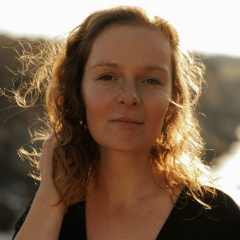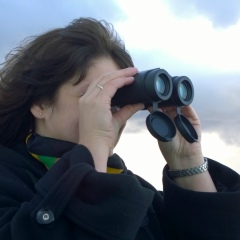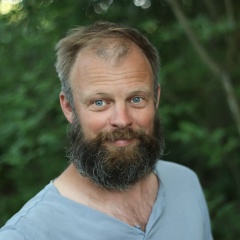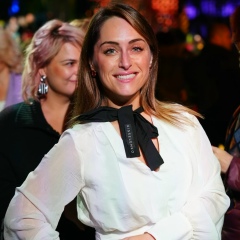Воскресенье 8 сентября. Ездили на фермерскую ярмарку. Место: Skillebyholm https://www.skillebyholm.com/ - большой хутор в районе Järna (час езды от Стокгольма на юг) со школой биодинамического сельского хозяйства (её основал швейцарец Thomas Lüthi в 1974 году), фермой (сады, огороды, цветы), рестораном, магазином органической еды и парком, используемым для проведения мероприятий.
Море в 800 метрах от большинства зданий. Тут же располагается шведский исследовательский институт биодинамики http://sbfi.se/public/index.php/en/about
Марлин (хозяйка фермы Peterslund EkoOdling, где я тружусь) провела три года в этом месте обучаясь на земледельческом курсе. От Ytterjarna Skyllebyholm находится примерно в 5 км. В Ytterjärna https://ytterjarna.se/ много выходцев со всей Европы - это штайнеровский центр культуры и образования (работает вальдорфская школа), несколько ферм и центр по работе с людьми с ментальными заболеваниями. Действовала так же антропософская клиника, но она недавно была закрыта как не вписывающаяся в государственственную системы здравоохранения.
Итак про ярмарку. Выехали в 6.45. С учетом дороги (40 минут), сборки прилавков и выкладки продукции успели как раз к первым покупателям. Они появились уже в 9.45 - до официального открытия в 10 утра.
Производители с сертификатом Demeter https://en.wikipedia.org/wiki/Demeter_International были собраны рядом со входом на ярмарку - овощи и фрукты самого Skyllebyholm, примерно такой же по размеру большой прилавок Peterslund Eco Odlings, прилавок с куриными яйцами и мукой, пекарня из Järna и козоводы с сырами и овощами https://m.facebook.com/S%C3%B6rbro-G%C3%A5rd-503723359734660/ . Козьей фермой заведует бельгиец. Было ещё два маленьких лотка с овощами и один большой Ekolädan https://facebook.com/ekoladan (поставщик фермерской продукции), но уже без знака Demeter. Одно хозяйство с коровьими сырами, один прилавок с мясными копченостями и два пчеловода.
Остальная и значительно бОльшая масса прилавков была про весьма традицонный hand-made с большой добавленной стоимостью. Сыродавленные масла, яблочный сок, гранатовый сок, овощные коктейли, хлебцы и т.п. А также посуда из дерева, свечи, корзины, музыкальные инструменты, луки для стрельбы, одежда (на одном лотке вывеска гласила "From lady to hippie"). Дети из обычной школы в Järna торговали своей выпечкой (включая весьма продвинутую - веганскую, без сахара и глютена).
Овощеводов оказалось немного и у нашего большого прилавка постоянно была очередь минимум в 4 человека, при том что работали мы в 5-6 пар рук. Отлично расходилась морковка (200 руб за большой пучок), артишоки (700 руб за кг), кукуруза (за штуку 140 руб), а также свёкла, лук, чеснок, мангольд, петрушка, помидоры, фенхель (цены в шведских кронах см. на фото). Кабачки и огурцы, что удивительно пользовались слабым спросом. Тыквы, капусту и репу тоже распродали, их мы привезли не много. Остался только кейл (но его мы много взяли). Закрутки в банках (капуста, морковь, свёкла) на фоне свежих овощей шли не так бодро. Большая часть товара ушла до 2 часов дня.
Я побеседовал со шведской ассоциацией Demeter http://www.demeter.se/
Ekobank https://www.ekobanken.se/en/ (народный экологический банк Швеции, в этом году им 20 лет, мои фермеры работают именно с ними)
и народным банком JAK.se, который кроме всего прочего ещё издает журнал Grus & Guld про самодостаточность и самообеспечение. У сотрудницы координирующего офиса Skillebyholm спросил есть ли у них международные проекты (сайт только на шведском)? Ответ, что только с Китаем. Организация, в целом, государственная. Обучение для учащихся в агро-школе так или иначе сейчас субсидируется или кредитуется. Двеннадцать лет назад, когда училась Малин, учебу нужно было оплачивать самостоятельно.
С участников ярмарки Skillebyholm берет десятую часть с объема проданного.
На ферме Skillebyholm видел овец, большие теплицы с помидорами, перцем и огурцами и "цветочный сад" - посетители сами срезают цветы, которые им интересны и оплачивают свой букет на выходе. Парковая часть засажена яблонями, грушами и сливами - в том числе весьма вкусными.
Русскоязычную речь на ярмарке слышал два раза (в обоих случаях обращались к детям), англоязычную - постоянно, иногда - немецкую.
Регион Sörmland в целом богат местными малыми производствами (о чем сообщает сайт соответствующего кластера https://matkluster.se ), так что на ярмарке были представлены далеко не все действующие лица.
Море в 800 метрах от большинства зданий. Тут же располагается шведский исследовательский институт биодинамики http://sbfi.se/public/index.php/en/about
Марлин (хозяйка фермы Peterslund EkoOdling, где я тружусь) провела три года в этом месте обучаясь на земледельческом курсе. От Ytterjarna Skyllebyholm находится примерно в 5 км. В Ytterjärna https://ytterjarna.se/ много выходцев со всей Европы - это штайнеровский центр культуры и образования (работает вальдорфская школа), несколько ферм и центр по работе с людьми с ментальными заболеваниями. Действовала так же антропософская клиника, но она недавно была закрыта как не вписывающаяся в государственственную системы здравоохранения.
Итак про ярмарку. Выехали в 6.45. С учетом дороги (40 минут), сборки прилавков и выкладки продукции успели как раз к первым покупателям. Они появились уже в 9.45 - до официального открытия в 10 утра.
Производители с сертификатом Demeter https://en.wikipedia.org/wiki/Demeter_International были собраны рядом со входом на ярмарку - овощи и фрукты самого Skyllebyholm, примерно такой же по размеру большой прилавок Peterslund Eco Odlings, прилавок с куриными яйцами и мукой, пекарня из Järna и козоводы с сырами и овощами https://m.facebook.com/S%C3%B6rbro-G%C3%A5rd-503723359734660/ . Козьей фермой заведует бельгиец. Было ещё два маленьких лотка с овощами и один большой Ekolädan https://facebook.com/ekoladan (поставщик фермерской продукции), но уже без знака Demeter. Одно хозяйство с коровьими сырами, один прилавок с мясными копченостями и два пчеловода.
Остальная и значительно бОльшая масса прилавков была про весьма традицонный hand-made с большой добавленной стоимостью. Сыродавленные масла, яблочный сок, гранатовый сок, овощные коктейли, хлебцы и т.п. А также посуда из дерева, свечи, корзины, музыкальные инструменты, луки для стрельбы, одежда (на одном лотке вывеска гласила "From lady to hippie"). Дети из обычной школы в Järna торговали своей выпечкой (включая весьма продвинутую - веганскую, без сахара и глютена).
Овощеводов оказалось немного и у нашего большого прилавка постоянно была очередь минимум в 4 человека, при том что работали мы в 5-6 пар рук. Отлично расходилась морковка (200 руб за большой пучок), артишоки (700 руб за кг), кукуруза (за штуку 140 руб), а также свёкла, лук, чеснок, мангольд, петрушка, помидоры, фенхель (цены в шведских кронах см. на фото). Кабачки и огурцы, что удивительно пользовались слабым спросом. Тыквы, капусту и репу тоже распродали, их мы привезли не много. Остался только кейл (но его мы много взяли). Закрутки в банках (капуста, морковь, свёкла) на фоне свежих овощей шли не так бодро. Большая часть товара ушла до 2 часов дня.
Я побеседовал со шведской ассоциацией Demeter http://www.demeter.se/
Ekobank https://www.ekobanken.se/en/ (народный экологический банк Швеции, в этом году им 20 лет, мои фермеры работают именно с ними)
и народным банком JAK.se, который кроме всего прочего ещё издает журнал Grus & Guld про самодостаточность и самообеспечение. У сотрудницы координирующего офиса Skillebyholm спросил есть ли у них международные проекты (сайт только на шведском)? Ответ, что только с Китаем. Организация, в целом, государственная. Обучение для учащихся в агро-школе так или иначе сейчас субсидируется или кредитуется. Двеннадцать лет назад, когда училась Малин, учебу нужно было оплачивать самостоятельно.
С участников ярмарки Skillebyholm берет десятую часть с объема проданного.
На ферме Skillebyholm видел овец, большие теплицы с помидорами, перцем и огурцами и "цветочный сад" - посетители сами срезают цветы, которые им интересны и оплачивают свой букет на выходе. Парковая часть засажена яблонями, грушами и сливами - в том числе весьма вкусными.
Русскоязычную речь на ярмарке слышал два раза (в обоих случаях обращались к детям), англоязычную - постоянно, иногда - немецкую.
Регион Sörmland в целом богат местными малыми производствами (о чем сообщает сайт соответствующего кластера https://matkluster.se ), так что на ярмарке были представлены далеко не все действующие лица.
Sunday, September 8th. We went to a farm fair. Location: Skillebyholm https://www.skillebyholm.com/ - a large farm in the Järna area (an hour drive from Stockholm to the south) with a school of biodynamic agriculture (founded by Swiss Thomas Lüthi in 1974), a farm (gardens, kitchen gardens, flowers ), a restaurant, an organic food store and a park used for events.
The sea is 800 meters from most buildings. There is also a Swedish Institute of Biodynamics http://sbfi.se/public/index.php/en/about
Marlin (the hostess of the Peterslund EkoOdling farm where I work) spent three years in this place studying on an agricultural course. Ytterjarna Skyllebyholm is approximately 5 km away. There are many people from all over Europe at Ytterjärna https://ytterjarna.se/ - the Steiner Center for Culture and Education (the Waldorf School operates), several farms and a center for working with people with mental illnesses. The anthroposophical clinic also acted, but it was recently closed as not fitting into the state healthcare system.
So about the fair. We left at 6.45. Given the road (40 minutes), the assembly of the counters and the calculation of the products were in time for the first customers. They appeared already at 9.45 - before the official opening at 10 am.
Producers with a Demeter certificate https://en.wikipedia.org/wiki/Demeter_International were gathered near the entrance to the fair - Skyllebyholm fruits and vegetables, about the same size as a large Peterslund Eco Odlings counter, a chicken and egg counter, a bakery from Järna and goats with cheese and vegetables https://m.facebook.com/S%C3%B6rbro-G%C3%A5rd-503723359734660/. The goat farm is run by a Belgian. There were two more small trays with vegetables and one large Ekolädan https://facebook.com/ekoladan (supplier of farm products), but already without the Demeter sign. One farm with cow cheeses, one smoked meat counter and two beekeepers.
The rest and a significantly larger mass of counters were about very traditional hand-made with great added value. Cheese, butter juice, apple juice, pomegranate juice, vegetable smoothies, bread rolls, etc. And also wooden dishes, candles, baskets, musical instruments, bows for shooting, clothes (on one tray the sign read "From lady to hippie"). Children from a regular school in Järna sold their pastries (including the very advanced one - vegan, sugar and gluten free).
There were few vegetable growers and our large counter always had a line of at least 4 people, despite the fact that we worked in 5-6 pairs of hands. Carrots (200 rubles per large bunch), artichokes (700 rubles per kg), corn (apiece 140 rubles), as well as beets, onions, garlic, chard, parsley, tomatoes, fennel (prices in Swedish crowns see at a photo). Zucchini and cucumbers, which are surprisingly in weak demand. Pumpkins, cabbage and turnips were also sold, we brought not many of them. Only the key remained (but we took a lot of it). Spins in jars (cabbage, carrots, beets) against the background of fresh vegetables did not go so vigorously. Most of the goods left before 2 pm.
I talked with the Swedish association Demeter http://www.demeter.se/
Ekobank https://www.ekobanken.se/en/ (Sweden’s People’s Ecological Bank, they are 20 this year, my farmers work with them)
and the People’s Bank JAK.se, which also publishes the Grus & Guld magazine about self-sufficiency and self-sufficiency. An employee of the coordinating office Skillebyholm asked if they have international projects (the site is only in Swedish)? The answer is that only with China. The organization as a whole is state-owned. Education for students in the agro-school is one way or another now subsidized or credited. Twelve years ago, when Malin was studying, study had to be paid for independently.
Skillebyholm takes a tenth of the volume sold from exhibitors.
At the Skillebyholm farm, I saw sheep, large greenhouses with tomatoes, peppers and cucumbers and a "flower garden" - visitors themselves cut flowers that are interesting to them and pay for their bouquet at the exit. The park part is planted with apples, pears and plums - including very tasty ones.
I heard Russian-language speech at the fair twice (in both cases I addressed children), English-language - constantly, sometimes - German.
The Sörmland region as a whole is rich in local small industries (as reported by the website of the corresponding cluster https://matkluster.se), so not all the actors were represented at the fair.
The sea is 800 meters from most buildings. There is also a Swedish Institute of Biodynamics http://sbfi.se/public/index.php/en/about
Marlin (the hostess of the Peterslund EkoOdling farm where I work) spent three years in this place studying on an agricultural course. Ytterjarna Skyllebyholm is approximately 5 km away. There are many people from all over Europe at Ytterjärna https://ytterjarna.se/ - the Steiner Center for Culture and Education (the Waldorf School operates), several farms and a center for working with people with mental illnesses. The anthroposophical clinic also acted, but it was recently closed as not fitting into the state healthcare system.
So about the fair. We left at 6.45. Given the road (40 minutes), the assembly of the counters and the calculation of the products were in time for the first customers. They appeared already at 9.45 - before the official opening at 10 am.
Producers with a Demeter certificate https://en.wikipedia.org/wiki/Demeter_International were gathered near the entrance to the fair - Skyllebyholm fruits and vegetables, about the same size as a large Peterslund Eco Odlings counter, a chicken and egg counter, a bakery from Järna and goats with cheese and vegetables https://m.facebook.com/S%C3%B6rbro-G%C3%A5rd-503723359734660/. The goat farm is run by a Belgian. There were two more small trays with vegetables and one large Ekolädan https://facebook.com/ekoladan (supplier of farm products), but already without the Demeter sign. One farm with cow cheeses, one smoked meat counter and two beekeepers.
The rest and a significantly larger mass of counters were about very traditional hand-made with great added value. Cheese, butter juice, apple juice, pomegranate juice, vegetable smoothies, bread rolls, etc. And also wooden dishes, candles, baskets, musical instruments, bows for shooting, clothes (on one tray the sign read "From lady to hippie"). Children from a regular school in Järna sold their pastries (including the very advanced one - vegan, sugar and gluten free).
There were few vegetable growers and our large counter always had a line of at least 4 people, despite the fact that we worked in 5-6 pairs of hands. Carrots (200 rubles per large bunch), artichokes (700 rubles per kg), corn (apiece 140 rubles), as well as beets, onions, garlic, chard, parsley, tomatoes, fennel (prices in Swedish crowns see at a photo). Zucchini and cucumbers, which are surprisingly in weak demand. Pumpkins, cabbage and turnips were also sold, we brought not many of them. Only the key remained (but we took a lot of it). Spins in jars (cabbage, carrots, beets) against the background of fresh vegetables did not go so vigorously. Most of the goods left before 2 pm.
I talked with the Swedish association Demeter http://www.demeter.se/
Ekobank https://www.ekobanken.se/en/ (Sweden’s People’s Ecological Bank, they are 20 this year, my farmers work with them)
and the People’s Bank JAK.se, which also publishes the Grus & Guld magazine about self-sufficiency and self-sufficiency. An employee of the coordinating office Skillebyholm asked if they have international projects (the site is only in Swedish)? The answer is that only with China. The organization as a whole is state-owned. Education for students in the agro-school is one way or another now subsidized or credited. Twelve years ago, when Malin was studying, study had to be paid for independently.
Skillebyholm takes a tenth of the volume sold from exhibitors.
At the Skillebyholm farm, I saw sheep, large greenhouses with tomatoes, peppers and cucumbers and a "flower garden" - visitors themselves cut flowers that are interesting to them and pay for their bouquet at the exit. The park part is planted with apples, pears and plums - including very tasty ones.
I heard Russian-language speech at the fair twice (in both cases I addressed children), English-language - constantly, sometimes - German.
The Sörmland region as a whole is rich in local small industries (as reported by the website of the corresponding cluster https://matkluster.se), so not all the actors were represented at the fair.









У записи 28 лайков,
1 репостов,
830 просмотров.
1 репостов,
830 просмотров.
Эту запись оставил(а) на своей стене Сергей Дмитриев















































